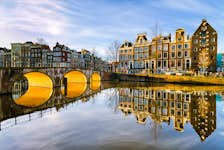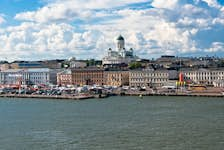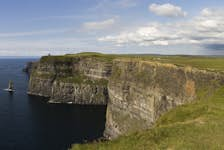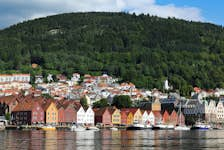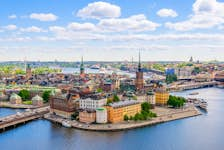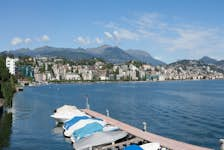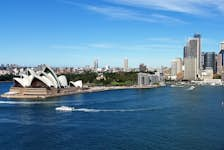Study in Lithuania
Lithuania is a crossroad between Western and Eastern Europe. Despite its complicated history, it has developed a unique culture, which encompasses both deep respect for traditions and a robust desire to learn and innovate.
We are members of the EU and NATO, and are among the most bilingual and educated nations in Europe. However, costs of living here are lower than in Western countries, which makes Lithuania ideal for aspiring international students.
Which universities to attend in Lithuania?
We recommend the following Lithuanian universities that offer English-taught degrees:
- ISM University of Management and Economics
- Kaunas University of Technology
- Lithuanian Sports University
- Vilnius Gediminas Technical University
- Mykolas Romeris University
What is it like to study in Lithuania?
All of the 350+ English-taught study programmes in Lithuania are evaluated according to the European Credit Transfer System (ECTS), with each year of study being awarded with 60 ECTS credits. University degrees are offered in three cycles:
- the first cycle is undergraduate (Bachelor's)
- the second cycle is graduate (Master's, and/or specialised professional studies)
- the third one is postgraduate (PhD/Doctoral, residency, postgraduate in the Arts)
Bachelor's degrees and professional qualifications are offered at universities; professional qualifications, but not degrees, can be taken at colleges. The academic year starts in September and ends in mid-June and is divided into two semesters – spring and autumn. Students can opt to study full-time or part-time.
If you are at the second cycle stage (or aim to be there) and you want to study for a Master’s degree and/or a specialised professional qualification, one of the options open to you is the Integrated study programmes. These programmes combine university studies at the first and second cycles. The successful graduates are awarded a Master’s Diploma which testifies to their Master’s degree status.
Practice
Higher education institutions in Lithuania focus on giving students the skills they need in order to apply their knowledge in a practical way. Therefore, students are able to undertake educational, professional or scientific practices both locally and internationally. Opportunities for practical involvement include the following:
- EU programmes, such as Erasmus (Higher Education) and Comenius (intended for future teachers).
- IAESTE, an international, non-profit association which implements an exchange programme for students at technical universities, involving students from 86 countries and more than six thousand companies worldwide. In Lithuania, Kaunas University of Technology act as a representative.
- Student organisations, such as AIESEC.
It's quite common to directly approach companies and ask for opportunities for un-paid work experience. This will greatly improve your CV and also give you practical knowledge, which will come in handy when you are considered for a permanent position.
What to study in Lithuania?
Here are some of the most popular academic courses:
Why Study in Lithuania?
- Welcoming nation. Lithuanians are one of the most educated and bilingual nations in Europe. After your studies, you are sure to leave with many new acquaintances and life-long friends. So much, that you just might decide to stay :-)
- Good value for money. With higher education being notoriously expensive in most parts of the world, more than ¾ of international students in Lithuania agree they are getting a bang for their buck – with tuition fees starting from 1000EUR and generous scholarship schemes for top quality education. Not considering Lithuania would be a big mistake!
How to apply
The admission process is a piece of cake after you decide which programme you wish to study. Most universities have deadlines in June for the September intake, but international students are advised to apply as early as possible in order to leave more time to work out the details.
The following three steps are required to enrol at a Lithuanian university:
- First, you must have your education documents recognised in the Republic of Lithuania. The evaluation and recognition of foreign school-leaving certificates and higher education qualifications is carried out accordingly by the Lithuanian Centre for Quality Assessment in Higher Education (CQAHE)
- After the recognition of your qualifications, you can apply to a university (most of the time it can be done online)
Admission requirements
Here are some documents you might need to submit during your university application:
- A scan of your diploma (high school or Bachelor’s degree)
- A transcript/record of your previous courses
- A scan of your passport and/or birth certificate
- Your CV
- Testing scores
- Evidence of scholarship or funding
- Letters of recommendation (2 or 3)
- Portfolio and/or writing samples
Helpful ways to make sure you qualify for a Lithuanian university
Take preparation courses
This kind of courses enable degree-seeking students to get an extra educational boost just before they start their Master’s degree or other post-graduate degree programmes.
Try a pre-MBA, pre-Law, or pre-Medicine programme, as well as any other foundation or preparation courses that will allow you to study in the degree programme of your choice.
Improve your English through an English-language prep course
If you’re attending a degree programme in Lithuania, you will need to prove that your language skills are good enough to participate in the classes and understand the lectures. These courses will also prepare you for any of the English-language tests that universities require.
English-language tests
To study in Lithuania, you’ll need to provide proof of your English language proficiency. The certificates generally accepted by Lithuanian universities are:
- PTE Academic
- TOEFL iBT
- IELTS Academic
- C1 Advanced or C2 Proficiency
Still, you should always check your university’s website to be sure what the exact requirements are.
Insurance
If you’ve come from one of the 27 Member States of the European Union, Iceland, Liechtenstein, Norway or Switzerland and have a European card of health insurance, you are guaranteed state health care services in case of an accident. You need to be aware that the card does not cover the expenses of health care services provided by the private sector.
Students from EU above the age of 18 could be considered for insurance and get free medical care. To do so, they must present a document, proving their status as a student, to the territorial health insurance fund. Then, if you want to get registered at a health centre, you will have to fill in an application on a special form at the reception desk and present a document proving personal identity (with the photo and a National Identification Number).
Weather
If you have made the decision to study in Lithuania and are preparing to pack for your trip here, don’t forget that you are coming to a country where the weather is very different per season.
In summer you will see beautiful blossoms of various forms and colours; in autumn yellow, red and brown leaves fall from the trees; in winter you’ll be able to wade through big banks of snow and catch snowflakes, and in spring you will see the sun reflecting in the puddles.
Lithuania’s climate has gotten warmer in recent years; the average annual temperature is 6.5–7.9°C. July is the hottest month of the year (average temperature is about 19.7°C; the highest temperature is over 30°C). The coldest month is January (average temperature –2.9°C, lowest temperature may fall below –30°C).
The rain season is from April to October (60 - 65% of the annual rainfall). There may be rainy periods during summer when 30mm a day or even more has been measured.
Thus, in summer your luggage will probably be at least half the weight it would be in winter. Temperatures can rise up to 30°C in the warm season, although a light jacket and an umbrella could come in handy. In winter you will need a warm coat, gloves and a woolly hat. In spring and autumn you may need a pair of wellington boots (if that’s your style).
Geography
In size, Lithuania is bigger than the other two Baltic neighbours and has roughly the size of Ireland: 62,302km². Lithuania’s territory extends 373 km from East to West and 276 km from North to South, which means you can cross it easily in few hours by car. Lithuania shares borders with Latvia, Belarus, Poland and Russian Federation.
Students from outside of EU, have to get insurance before coming to Lithuania — either from a company based at home or within Lithuania.
Lithuania is also very flat — our highest hill rises 293.8 m above sea level, and we don‘t have any mountains (so we built the biggest indoor skiing centre in the region!). About one third of our land area is occupied by forests, and 4% — by rivers and lakes (which we have 830 of). We also have a 100km long coastline.
Living in Lithuania
Let's take a closer look at the tuition fees, living costs, and student life in Lithuania:
Tuition fees
At Lithuanian universities, tuition fees differ from one institution to another, depending on the type study programme and the level of education (undergraduate vs postgraduate). On average, the costs of studies at public higher education institutions are:
- between 1,000–5,300 EUR per year for Bachelor's degrees
- between 2,200–6,500 EUR per year for Master's degrees
- between 7,100–8,500 EUR per year for PhD degrees
Although these tuition fees are affordable compared to those in countries like the US or the UK, there are more good news:
- EU students can apply for state funded places
- All international students (including non-EU citizens) can apply for state funded PhD places
You can apply for scholarships that cover both tuition and living costs
If you want to study at private Lithuanian universities, be prepared to pay higher tuition fees.
Scholarships
Students of all fields, lecturers and researchers of higher education or research institutions of foreign countries are eligible to apply for Lithuanian state scholarships.
Usually (but not in all cases), scholarships cover both tuition-fee for studies/summer courses and living expenses. Financial provisions depend on the country you are applying from. There are 3 types of scholarships offered:
- For Lithuanian language and culture summer courses
- For short-term Lithuanian (Baltic) studies
- For full-time Master's degree studies in all fields
In addition to state scholarships, universities sometimes grant individual scholarships, which you can enquire about during the university application process.
Learn more about scholarships in Lithuania.
Accommodation
All universities offer the opportunity to live in a hall of residence. Some of the halls of residence are situated near the universities, others in the city centre. Some are further away so you will have to use public transport to get to university.
These student halls have been renovated and equipped with modern appliances; they all have internet access. However, not all residences have the same conditions
As an alternative, you can always rent a single flat or share one with other students. It will cost you between 300 and 700 EUR per month, plus the additional utilities (120–140 EUR).
Monthly expenses
Most foreign students say that 250–550 EUR is enough to live for a month (including food and groceries). It really depends on how much you want to travel and go out, but Lithuanian night clubs, pubs, museums and other attractions are less expensive than the ones found elsewhere in Europe:
- pint of beer: 2.50–3.50 EUR
- two-course meal at most restaurants: 3–5 EUR
- cinema ticket: 5–6 EUR
- 10 minutes at a carting track: 10–12 EUR
Leisure
Let's be real: choosing where to study is a lot about getting the best education, but you won't be spending 24/7 in the library, right? Lithuania has a lot to offer for your leisure activities: from going out and joining all the people who crowd various pubs and bars after lectures/work, to learning how to snowboard in the biggest in-doors skiing facility in Druskininkai, or visiting one of exhilarating tree-top adventure parks.
Most of the pubs and clubs in Lithuania are small to medium sized, each one with unique vibe and soul. And this soul is what you will notice on your first evening out - put on your friendly hat and be ready to mingle, because it is very common to go out with a few friends, and come back with a dozen.
There are lots of international students focused events, especially in the beginning of the term, which are the best way to get to know other students and make local friends. Apart from going out, being compact in size, Lithuania is convenient for domestic tourism — we have vast areas secured for national parks, where you can hike special trails, kayak, or bike.
If you are into more extreme ventures,maybe something like air ballooning other the tree tops, paint-ball in deserted army polygons or wakeboarding will be among things you will experience first in Lithuania.
About Lithuania
Lithuanians are one of the ethnic groups in the Baltic region. While Lithuania has a population of about 3 million people, at least another million are living in other countries, with Lithuanians generally located in the USA, Brazil, Canada, Columbia, Russia, the United Kingdom and Ireland. Lithuania is a member of EU and NATO.
The native language is Lithuanian, one of two living Baltic languages. An interesting fact about the language is that as far back as the beginning of the 19th century people noticed that Lithuanian was very similar to Sanskrit. Linguists around the world are still fascinated that the Lithuanian language has retained features of this ancient language and it hasn’t really simplified much.
Many Lithuanians are multilingual; two-thirds of the population declares that they are able to speak at least two foreign languages. This exceeds the average of the European Union several times. According to the data from Eurostat, 66.1 per cent of the population of Lithuania, aged 25 – 64, can speak two or more foreign languages, 31.5 per cent can speak one foreign language, and a mere 2.5 per cent of the population cannot speak any foreign languages. The most common foreign languages spoken are English, Russian and German.
83.45 per cent of the population of Lithuania consider themselves to be Lithuanians, 6.74 per cent are Polish, 6.31 per cent are Russians, 1.23 per cent are Belarusians and 2.27 per cent represent other nations. In terms of religion, most Lithuanians are Roman Catholic.
Another reason why Lithuania is amongst the top destinations for quality studies in Europe is that our population is amongst the top educated in Europe. We were among the best educated nations in Europe once more by the European Commision's Eurostat website, which compared all European countries against the same criteria. 93.3% of 25-64 year olds in Lithuania have upper secondary education (followed by 92.5% in Czech Republic, 91.7% in Slovakia and 89.8% in Estonia). Every third Lithuanian has a BA or higher degree.
Relevant links:
http://www.studyinlithuania.lt
How to Apply to a Master's in Lithuania
If you've decided to study a Master's degree at a university in Lithuania, you will have to gather the right documents to prove that you fit the university requirements. Provide complete personal information, previous qualifications, financial information, and a personal statement.
What documents do I need to provide to apply in Lithuania?
To apply to a university in Lithuania you will likely be asked to provide some of the following documents:
- birth certificate;
- recent photos;
- your passport or national identity card;
- one or more reference letters from past employers or teachers;
- copies of past diplomas or certificates, including your graduated Bachelor's degree;
- academic transcripts;
- letter of intent;
- Curriculum Vitae;
- Some form of proof that you can support your stay in the country during your studies.
Depending on the subject or specialization of your chosen Master's, you might also be asked to provide scores for additional tests like the GRE, GMAT or LSAT. Check if your programme requires any of these, or others.
The list of documents depends on the specific requirements of universities in Lithuania so you might be asked to include additional documents. It’s also likely you’ll have to provide official English translations of your documents, or translations in the local language.
Prove your English skills
Because you’ll study an international degree in English, you'll have to present a language certificate. Some popular options for international students are IELTS, TOEFL or C1 Advanced language certificates. You’ll have to meet a minimum language score set by the university, and your test scores shouldn’t be older than 1-2 years. If you don’t meet the minimum language requirements, you will have to improve your skills and scores by taking an English preparation course.
Application deadlines for Lithuania
The deadlines for applying to a Master's in Lithuania are usually during summer (June-July), or in winter (January-February). Keep in mind that some universities don’t have application deadlines, which means you can apply whenever you are ready.
To avoid delays or missed deadlines send your required documents with plenty of time in advance.


